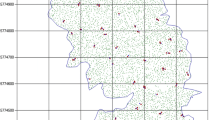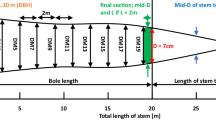Abstract
A novel fixed-count (FC) estimator of stem density and inverse distance weighted (IDW) fixed-count estimators of mean diameter (DBH) and basal area (BA) were tested in simulated simple random sampling from 30 actual stands and two methods for correcting edge effects. Estimates of the average bias, in designs with a sample size of 15 and recording of distances and tree attributes in the six nearest trees at each sample location, were in the order of 1–2 %. Root mean squared errors were approximately 1 % greater than corresponding estimates for sampling with fixed-area plots (FX) of a commensurate size. Coverage of FC nominal 95 % confidence intervals was somewhat conservative. The positive results with DBH and BA were only possible with the proposed IDW. Corrections for edge effects were not effective in FC. A strong correlation between results obtained with FC and FX vouch for a rational weighing of pros and cons of FC versus FX sampling.




Similar content being viewed by others
References
Banerjee S, Gelfand AE (2007) Bayesian wombling: curvilinear gradient assessment under spatial process models. J Am Stat Assoc 101(476):1487–1501
Banerjee S, Wall MM, Carlin BP (2003) Frailty modeling for spatially correlated survival data, with application to infant mortality in Minnesota. Biostatistics 4(1):123–142
Bitterlich W (1952) Die Winkelzählprobe – Ein optisches Messverfahren zur raschen Aufnahme besonders gearteter Probeflächen für die Bestimmung der Kreisflächen pro Hektar an stehenden Waldbeständen. Forstwiss Cbl 71(7–8):215–225
Bitterlich W (1984) The relascope idea. Commonwealth Agricultural Bureaux, Slough
Burkhart HE, Tomé M (2012) Indices of individual-tree competition. In: Modeling forest trees and stands. Springer, Dordrecht, pp 201–232. doi:10.1007/978-90-481-3170-9_9
Casella G, Berger RL (2002) Statistical inference, 2nd edn. Duxbury Press, Pacific Grove
Cleves MA, Gould WW, Gutierrez RG (2004) An introduction to survival analysis using STATA®. STATA Press, College Stn., TX
Clutter JL, Fortson JC, Brister GH, Bailey RL (1983) Timber management: a quantitative approach. Wiley, New York
Cochran WG (1977) Sampling techniques. Wiley, New York
Delince J (1986) Robust density estimation through distance measurements. Ecology 67:1576–1581
Diggle PJ (1976) A spatial stochastic model of inter plant competition. J Appl Prob 13:662–671
Eberhardt LL (1967) Some developments in ‘distance sampling’. Biometrics 27(2):207–216
Efron B, Tibshirani RJ (1993) An introduction to the bootstrap. Chapman & Hall, Boca Raton
Fehrmann L, Gregoire T, Kleinn C (2011) Triangulation based inclusion probabilities: a design-unbiased sampling approach. Environ Ecol Stat 19(1):107–123
Filipescu CN, Groot A, MacIsaac DM, Cruickshank MG, Stewart JD (2012) Prediction of diameter using height and crown attributes: a case study. W J Appl For 27(1):30–35
Genet A, Grabarnik P, Sekretenko O, Pothier D (2014) Incorporating the mechanisms underlying inter-tree competition into a random point process model to improve spatial tree pattern analysis in forestry. Ecol Model 288:143–154
Gregoire TG, Scott CT (2003) Altered selection probabilities caused by avoiding the edge in field surveys. J Agric Biol Environ Stat 8(1):36–47
Gregoire TG, Valentine HT (2008) Sampling strategies for natural resources and the environment. Chapman & Hall/CRC, Boca Raton
Gutierrez RG (2002) Parametric frailty and shared frailty survival models. Stata J 2(1):22–44
Hamilton GJ (1969) The dependence of volume increment of individual trees on dominance, crown dimension, and competition. J For 42:133–144
Haxtema Z, Temesgen H, Marquardt T (2012) Evaluation of n-tree distance sampling for inventory of headwater riparian forests of Western Oregon. W J Appl For 27(3):109–117. doi:10.5849/wjaf.10-035
Holmgren J, Joyce S, Nilsson M, Olsson H (2000) Estimating stem volume and basal area in forest compartments by combining satellite image data with field data. Scand J For Res 15(1):103–111
Hradetzky J, Schöpfer W (2013) Stichprobenverfahren der temporären Betriebsinventur im Vergleich. FVA-Einblick, Freiburg, pp 16–19
Illian J, Penttinen A, Stoyan H, Stoyan D (2008) Statistical analysis and modelling of spatial point patterns. Statistics in Practice. Wiley, Chichester
Jonsson B, Holm S, Kallur H (1992) A forest inventory method based on density-adapted circular plot size. Scand J For Res 7(1):405–421
Jucker T, Bouriaud O, Coomes DA (2015) Crown plasticity enables trees to optimize canopy packing in mixed-species forests. Func Ecol. doi:10.1111/1365-2435.12428
Kangas A, Maltamo M (2006) Forest inventory: methodology and applications, vol 10. Springer, New York
Kleinn C, Vilčko F (2006a) Design-unbiased estimation for point-to-tree distance sampling. Can J For Res 36:1407–1414
Kleinn C, Vilčko F (2006b) A new empirical approach for estimation in k-tree sampling. For Ecol Manag 237(1–3):522–533
Kotz S, Johnson NL (1988) Taylor-series linearization. In: Kotz S, Johnson NL (eds) Encyclopedia of statistical sciences. Wiley, New York, pp 646–647
Kronenfeld BJ (2009) A plotless density estimator based on the asymptotic limit of ordered distance estimation values. For Sci 55(10):283–292
Lessard VC, Reed D, Monkevich N (1994) Comparing n-tree distance sampling with point and plot sampling in northern Michigan forest types. N J Appl For 11(1):12–16
Lin L, Hedayat AS, Sinha B, Yang M (2002) Statistical methods in assessing agreement: models, issues and tools. J Am Stat Assoc 97(457):257–270
Lindsey AA, Barton JD, Miles SR (1958) Field efficiencies of forest sampling methods. Ecology 39(3):428–444
Lynch TB (2012) A mirage boundary correction method for distance sampling. Can J For Res 42(2):272–278. doi:10.1139/x11-185
Lynch TB (2015) Voronoi polygons quantify bias when sampling the nearest plant. Can J For Res (in press). doi:10.1139/cjfr-2015-0238
Lynch TB, Rusydi R (1999) Distance sampling for forest inventory in Indonesian teak plantations. For Ecol Manag 113(2–3):215–221
Lynch TB, Wittwer RF (2003) n-Tree distance sampling for per-tree estimates with application to unequal-sized cluster sampling of increment core data. Can J For Res 33(7):1189–1195
Magnussen S (2012a) Fixed-count density estimation with virtual plots. Spatial Stat 2:33–46. doi:10.1016/j.spasta.2012.09.001
Magnussen S (2012b) A new composite k-tree estimator of stem density. Eur J For Res 131(5):1513–1527. doi:10.1007/s10342-012-0619-4
Magnussen S (2014) Robust fixed-count density estimation with virtual plots. Can J For Res 44(4):377–382
Magnussen S (2015) A fixed count sampling estimator of stem density based on a survival function. J For Sci 61(11):485–495
Magnussen S, Kleinn C, Picard N (2008a) Two new density estimators for distance sampling. Eur J For Res 127(3):213–224
Magnussen S, Picard N, Kleinn C (2008b) A Gamma-Poisson distribution of point to k nearest event distance. For Sci 54(4):429–441
Mäkelä H, Pekkarinen A (2004) Estimation of forest stand volumes by Landsat TM imagery and stand-level field-inventory data. For Ecol Manag 196(2):245–255
Moore PG (1954) Spacing in plant populations. Ecology 35(2):222–227. doi:10.2307/1931120
Morisita M (1954) Estimation of population density by spacing method, vol 69. University of Kyushu, Kyushu
Næsset E (2002) Predicting forest stand characteristics with airborne scanning laser using a practical two-stage procedure and field data. Remote Sens Environ 80(1):88–99
Nothdurft A (2013) Spatio-temporal prediction of tree mortality based on long-term sample plots, climate change scenarios and parametric frailty modeling. For Ecol Manage 291:43–54. doi:10.1016/j.foreco.2012.11.028
Nothdurft A, Saborowski J, Breidenbach J (2009) Spatial prediction of forest stand variables. Eur J For Res 128(3):241–251. doi:10.1007/S10342-009-0260-Z
Nothdurft A, Saborowski J, Nuske RS, Stoyan D (2010) Density estimation based on k-tree sampling and point pattern reconstruction. Can J For Res 40(5):953–967. doi:10.1139/x10-046
Oehlert GW (1992) A note on the delta method. Am Stat 46(1):27–29
Okabe A, Boots B, Sugihara K, Chiu SN (2000) Spatial tessellations. Concepts and applications of Voronoï diagrams. Wiley, Chicester
Patil SA, Kovner JL, Burnham KP (1982) Optimum nonparametric estimation of population density based on ordered distances. Biometrics 35:597–604
Payandeh B, Ek AR (1986) Distance methods and density estimators. Can J For Res 16:918–924
Perry DA, Cannell MGR, Jackson JE (1985) The competition process in forest stands. Trees as crop plants. Inst. Terr. Ecol, Huntingdon, pp 481–506
Persson O (1964) Distance methods: the use of distance measurements in the estimation of seedling density and open space frequency. Studia Forestalia Suecica. Skogshögskolan, Stockholm
Picard N, Kouyaté AM, Dessard H (2005) Tree density estimations using a distance method in Mali Savanna. For Sci 51(1):7–18
Pollard JH (1971) On distance estimators of density in randomly distributed forests. Biometrics 27:991–1002
Prodan M (1968) Punktstichprobe für die Forsteinrichtung (in German). Forst- und Holzwirt 23(11):225–226
Ritter T, Nothdurft A, Saborowski J (2013) Correcting the nondetection bias of angle count sampling. Can J For Res 43(999):344–354
Schöpfer W (1967) Ein Stichprobensimulator für Forschung und Lehre. Allg F Jagdztg 138:267–273
Schreuder HT (2004) Sampling using a fixed number of trees per plot. USDA Forest Service, RMRS-RN-17, USDA Forest Service, Fort Collins, pp 1–3
Staupendahl K (2008) The modified six-tree-sample—a suitable method for forest stand assessment. Allg F Jagdztg 179(2–3):21–33
Yoda K, Kira T, Hozumi K (1957) Intraspecific competition among higher plants IX. Further analysis of the competitive interaction between adjacent individuals. J Inst Polytech Osaka Univ D 8:161–178
Author information
Authors and Affiliations
Corresponding author
Additional information
Handling editor: Arne Nothdurft.
Rights and permissions
About this article
Cite this article
Magnussen, S. Improved fixed-count stand-level estimators of stem density, mean diameter, and basal area. Eur J Forest Res 135, 191–202 (2016). https://doi.org/10.1007/s10342-015-0930-y
Received:
Revised:
Accepted:
Published:
Issue Date:
DOI: https://doi.org/10.1007/s10342-015-0930-y




